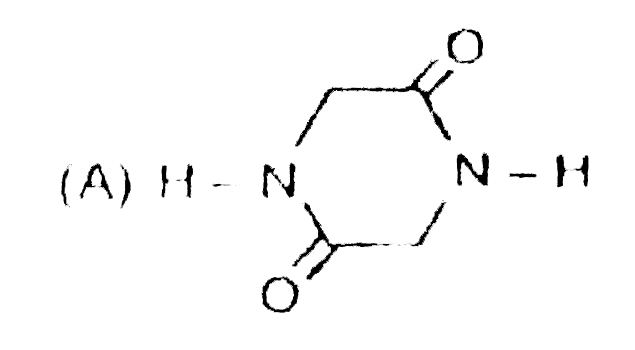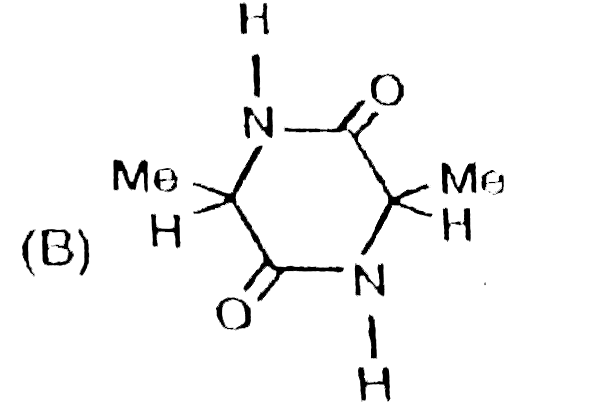What will be product when glycine, is heated -




The correct Answer is:A
To determine the product when glycine is heated, we can follow these steps:
Step 1: Understand the Structure of Glycine
Glycine is the simplest amino acid with the chemical formula CH₂(NH₂)COOH. Its structure can be represented as:
H|H2N−C−COOH|H
This shows that glycine has an amino group (NH₂), a carboxylic acid group (COOH), and a hydrogen atom attached to the central carbon.
Step 2: Consider the Heating Process
When glycine is heated, it can undergo dehydration, which involves the removal of water molecules. In this case, two molecules of glycine can interact with each other.
Step 3: Combine Two Glycine Molecules
When two molecules of glycine are heated, they can react as follows:
H2N−CH2−COOH+H2N−CH2−COOH
By removing two water molecules (one from each glycine), the reaction can be represented as:
H2N−CH2−COOH+H2N−CH2−COOH→(Cyclic∏uct)+2H2O
Step 4: Identify the Cyclic Product
The removal of water leads to the formation of a cyclic compound. The structure of the cyclic product can be visualized as follows:
- The two glycine molecules lose a water molecule each (OH from one and H from the other).
- This results in the formation of a cyclic structure where the nitrogen atoms from the amino groups are connected.
The cyclic product formed is called 2,5-diketopiperazine, which is a cyclic dipeptide.
Step 5: Finalize the Product
After the reaction, the product can be represented as:
NCH2C=O||CN||C=OH
This structure represents the cyclic compound formed from the dehydration of glycine.
Conclusion
Thus, when glycine is heated, it results in the formation of a cyclic compound, specifically 2,5-diketopiperazine.
---
Glycine is the simplest amino acid with the chemical formula CH₂(NH₂)COOH. Its structure can be represented as:
H|H2N−C−COOH|H
This shows that glycine has an amino group (NH₂), a carboxylic acid group (COOH), and a hydrogen atom attached to the central carbon.
When glycine is heated, it can undergo dehydration, which involves the removal of water molecules. In this case, two molecules of glycine can interact with each other.
When two molecules of glycine are heated, they can react as follows:
H2N−CH2−COOH+H2N−CH2−COOH
By removing two water molecules (one from each glycine), the reaction can be represented as:
H2N−CH2−COOH+H2N−CH2−COOH→(Cyclic∏uct)+2H2O
The removal of water leads to the formation of a cyclic compound. The structure of the cyclic product can be visualized as follows:
- The two glycine molecules lose a water molecule each (OH from one and H from the other).
- This results in the formation of a cyclic structure where the nitrogen atoms from the amino groups are connected.
After the reaction, the product can be represented as:
NCH2C=O||CN||C=OH
This structure represents the cyclic compound formed from the dehydration of glycine.
Thus, when glycine is heated, it results in the formation of a cyclic compound, specifically 2,5-diketopiperazine.
Topper's Solved these Questions
Similar Questions
What is the product obtained when glycine hydrochloride reacts with two equivalents of NaOH ? Write the chemical reactions involved.
View SolutionWrite the product when acetone is heated with barium hydroxide.
View Solutionwhat is the R group in glycine?
View SolutionWhat is the product when acetylene reacts with HOCl
View SolutionWhat colour is observed when ZnO is heated ?
View SolutionWhat will be the product formed when chlorobenzene is heated with sodium metal in the presence of dry ether?
View SolutionWhat product is formed when acetic acid heated with P2O5
View SolutionName the products formed when copper is heated with concentrated sulphuric acid.
View SolutionWhich is the major product formed when acetone is heated with iodine and potassium hydroxide ?
View SolutionWhat is the product formed when ozone reacts with mercury?
View Solution
